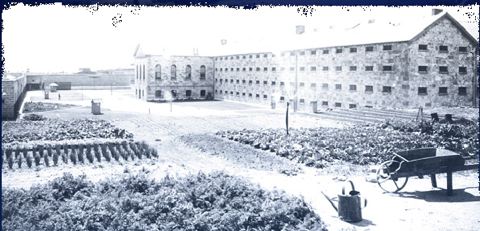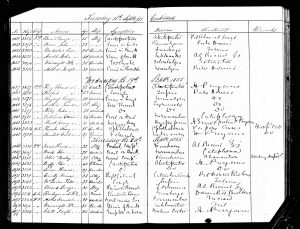A Western Australian Convict
On 2 February 1855 George departed for Western Australia with 224 other convicts onboard the “Stag”, which sailed from London with Surgeon Superintendent Caldwell on board.1,2,,3,4 They arrived in Fremantle on 23 May 1855, the fourteenth convict ship to arrive on its shores.1,,2,,3 The Swan River Settlement in Western Australia was founded by free settlers on 2nd May 1829 by Captain Fremantle, however after 20 years of struggling to make an existence, a request was made to start accepting convicts to provide much needed labour.5 George Brand was one of the almost 10,000 convicts to arrive on Western Australian shores, on 43 convict ships from 1850 until 1868 when transportation ceased.5



Do you have a convict ancestor? Click on the below image to start searching for your convict ancestors at Findmypast today.
Image Credit: Fremantle Prison. https://petergreenberg.com/wp-content/uploads/2010/02/fremantle.jpg. Accessed 10 June 2016.
- 1. Erickson, Rica. The Brand on his Coat: Biographies of some Western Australian Convicts. Nedlands: University of Western Australia Press, 1983.
- 2. Fremantleprison.com.au. ‘Convict Database’. https://fremantleprison.com.au/history-heritage/history/the-convict-era/. Accessed 16 May 2016.
- 3. Erickson, Rica and O’Mara, Gillian. The Bicentennial dictionary of Western Australians. V. 9. Convicts in Western Australia, 1850-1887. Nedlands, W.A.: University of Western Australia, 1987-[1997].[Revision of Dictionary of Western Australians Vol. 2 Bond 1850-1868. Alphabetical listing of convicts and short biography of each].
- 4. Ancestry.com. Western Australia, Australia, Convict Records, 18461930 [database on-line]. Provo, UT, USA: Ancestry.com Operations, Inc., 2015. Original Data: Convict Records. State Records Office of Western Australia, Perth, Western Australia, Australia. Convict Department, Registers: Reference Number: ACC 1156/R18. Accessed 16 May 2016.
- 5. State Records Office of Western Australia. ‘Convict Records’. http://www.sro.wa.gov.au/archive-collection/collection/convict-records. Accessed 1 June 2016.
- 6. Fremantleprison.com.au. ‘History: The Convict Era’. https://fremantleprison.com.au/history-heritage/history/the-convict-era/. Accessed 10 June 2016.
- 7. Ancestry.com. Western Australia, Australia, Convict Records, 18461930 [database on-line]. Provo, UT, USA: Ancestry.com Operations, Inc., 2015. Original Data: Convict Records. State Records Office of Western Australia, Perth, Western Australia, Australia. Convict Department. Convict Department Reel Number: FCN42, Reference Number: ACC 128/40-43. Accessed16 May 2016.
- 8. Ancestry.com. Western Australia, Australia, Convict Records, 18461930 [database on-line]. Provo, UT, USA: Ancestry.com Operations, Inc., 2015. Original Data: Convict Records. State Records Office of Western Australia, Perth, Western Australia, Australia. Convict Department, Superintendent Orders: Reference Number: ACC 1156/SO4-SO6. Accessed 16 May 2016.
- 9. Ancestry.com. Western Australia, Australia, Convict Records, 18461930 [database on-line]. Provo, UT, USA: Ancestry.com Operations, Inc., 2015. Original Data: Convict Records. State Records Office of Western Australia, Perth, Western Australia, Australia. Convict Establishment, Medical: Reference Number: ACC 1156/M14-M16. Accessed 16 May 2016.
- 10. Archaicmedicalterms.com. ‘List of English Causes of Death’. http://www.archaicmedicalterms.com/English/English.htm. Accessed 5 June 2016.

This was a very well documented and well researched example of how Australia was used to rehabilitate criminals. I very much enjoyed reading it, I felt like I was there, living George’s life. Thank you for sharing this. I had heard that Australia was a penal colony at one point, it sounds like an excellent way to teach convicts a task other than crime. I was very impressed with the layout of the page, and as I said before the citing of your research. You did a very thorough job!
Hi Rae
I am so glad that you enjoyed reading about George Brand and the Australian Penal Colony history. Please come back and read some more.
Regards,
Megan
This didn’t register my first comment so I will leave another. I had heard that Australia was used as a penal colony quite a while ago, it seemed a good way to rehabilitate those that needed it. Our prisons in America are so over crowded there is very little room for rehabilitation. It really is a shame. You did an excellent job citing your research, I very much enjoyed reading the story. Perhaps I’ll have to get into Genealogy myself. Thank you for sharing this true story.
Hello Rae
Thank you for reading and taking the time to comment. Australia was founded as a penal colony, and whilst there were some who didn’t reform, there were many others who used their punishment to learn from their mistakes. We have some beautiful buildings around the country built by convicts. However, like America, we have a very overcrowded prison system that is so overworked that rehabilitation is not possible. Thanks again for your comment and I hope you come back and read some more here. I hope you do get into genealogy as it is a fascinating hobby especially being able to put your ancestors into historical context like I did with George. Please let me know if there is anything I can help you with in researching your family.
Regards,
Megan
This was an outstanding article. I had heard that Australia was a penal colony for a long time, but knowing they were convicts at the end of their sentences and taken there to work makes a great deal of sense. We need that now in America. Our prisons are so over crowded it’s just ridiculous and in my opinion there is no rehabilitation going on to help them. You did an exceptional job documenting your cites. Thank you for sharing this with us.
I realized afterward posting my comment that I needed to go back and read from part 1.
It’s amazing that you were able to dig up so much detailed information about George and his proclivity to take what did not belong to him. Yet that is probably part of the reason you were able to find so much documentation about his crimes, family and activities.
His story also shows that Australia was indeed developing into the land of the ‘fair go’.
~Jude
Hi Jude
That’s what I love about researching a convict, is there is such a wealth of information. This is because the government kept good records of the criminal and their sentence. It is very easy to track them this way. Often when they leave the convict system there is no trace of them, however, I was fortunate there was with George as he stayed in the area where he served out his time. He then went to become a well-respected member of the community. As his grandson, David, went on to do great things in Western Australian politics it was part of his legacy and another trail. Others aren’t quite as lucky in finding what happened to their convict afterward. I’m glad you enjoyed reading about George and learning more about the Western Australian convict system.
Regards,
Megan
The research you’ve undertaken for this post is impressive. I enjoyed reading about George Brand at the Swan River Settlement.
Having moved to Australia from Canada, I did a bit of research before moving. I recall reading that in England in the 1850s, stealing food could mean deportation. It was shocking to learn that if the theft value was $50, it could mean death by hanging.
A bit of irony that convicts actually built the establishment where George lived.
In the description of George, his health and activities, you give us a good picture of his life as a convict.
I look forward to reading Part 2 and learning more about George Brand’s success story.
~Jude
Hello Jude
I’m so glad you enjoyed reading about George in the Swan River Settlement. This is actually a 5-part series and this was Part 4. You’ll find part 1 here and the links to the other parts in the series at the bottom of the article. I really hope you enjoy reading what crimes he committed to get sent to Western Australia. Thank you for letting me know how much you enjoyed this post. I hope you will come back and read more at Walking the Genes soon.
Regards,
Megan